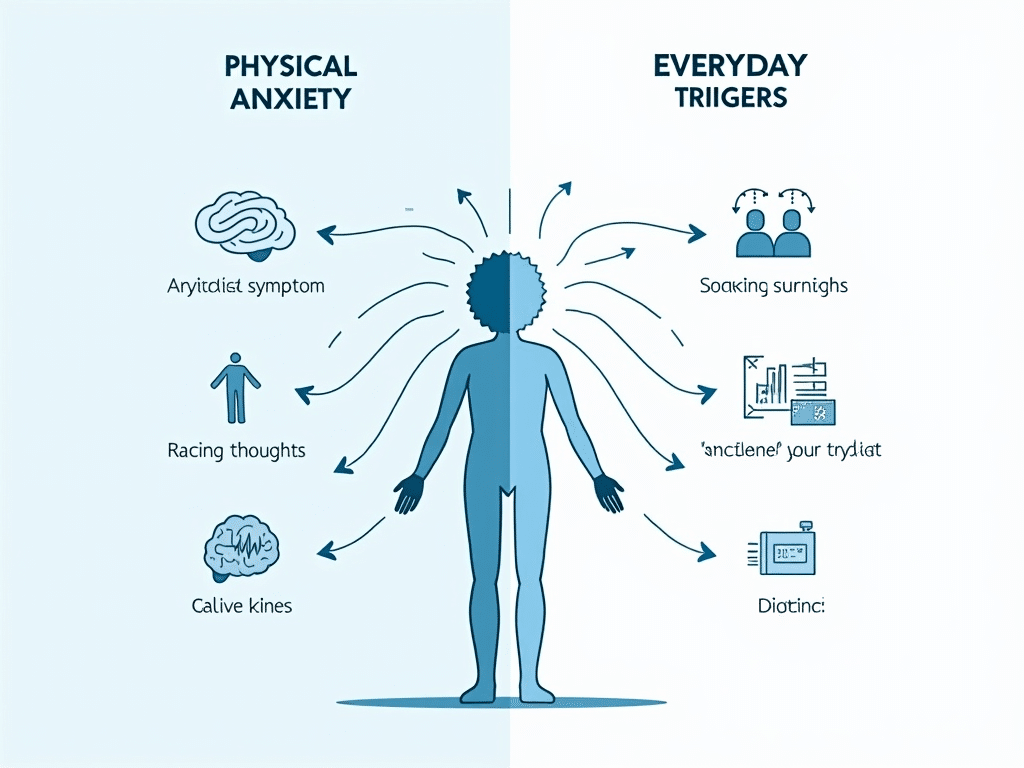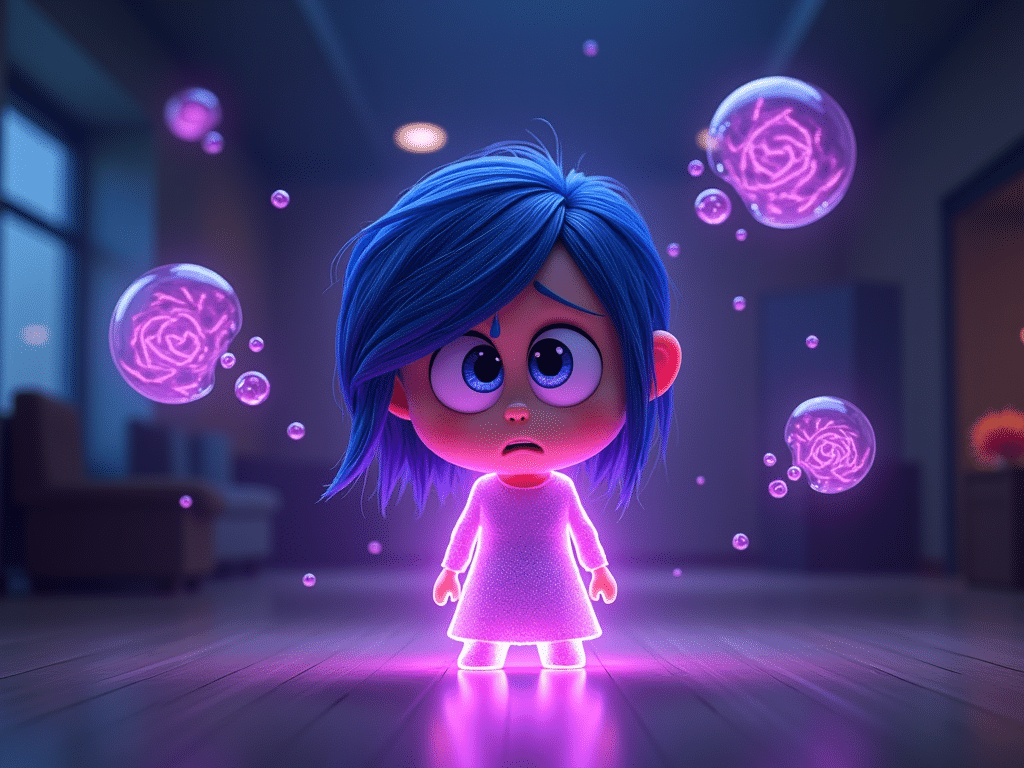Hey there, anxiety warriors! Let’s talk about that pesky feeling that sometimes makes your heart race faster than a TikTok trend. You know, that “OMG, what if…” thought that pops into your head right before a big test or when you’re about to slide into someone’s DMs. Yep, we’re talking about anxiety. It’s like that annoying friend who always shows up uninvited to the party. But don’t worry, we’re gonna break it down and figure out how to deal with this unwelcome guest. Let’s get started! 🚀
| Key Takeaways | Description |
|---|---|
| Definition | Anxiety is a natural response to stress, but can become a disorder if excessive |
| Symptoms | Physical (rapid heartbeat), emotional (worry), cognitive (racing thoughts), and behavioral |
| Types | Includes generalized anxiety, social anxiety, panic disorder, and specific phobias |
| Management | Techniques include relaxation, mindfulness, exercise, and professional help when needed |
Anxiety: Understanding the Worry Monster and How to Tame It 😰

What is Anxiety?
Alright, let’s break it down. Anxiety is like your brain’s built-in alarm system. It’s that feeling you get when you’re facing something stressful or potentially dangerous. You know, like when you’re about to give a speech in front of the whole class and suddenly your palms are sweating more than a giga chad at the gym.
Here’s the thing: a little anxiety is totally normal and can even be helpful. It’s what keeps you alert and focused when you need to be. But when anxiety starts crashing your vibe on the regular and messing with your daily life, that’s when it becomes a problem.
Anxiety can show up in different ways:
- Physical symptoms: Your heart races, you get sweaty, your stomach does somersaults.
- Emotional symptoms: You feel worried, restless, or on edge all the time.
- Cognitive symptoms: Your thoughts are racing faster than Usain Bolt.
- Behavioral symptoms: You start avoiding situations that make you anxious.
Anxiety Inside Out 2

Now, let’s take a quick detour into the world of Pixar. Have you seen “Inside Out 2”? If not, no worries, I got you. In this movie, they introduce a new character called Anxiety. And let me tell you, they nailed it.
Anxiety in the movie is portrayed as this frantic, always-on-alert character who’s constantly looking out for potential threats. Sound familiar? It’s like they took a peek inside all our brains!
The cool thing about the movie is that it shows how anxiety can actually be helpful sometimes. Like when it warns Joy about potential dangers. But it also shows how anxiety can go overboard and start messing things up if it’s not kept in check.
Anxiety Symptoms
Okay, so how do you know if you’re dealing with anxiety? Well, it’s like your body and mind are throwing a party, but it’s the kind of party you definitely don’t want an invite to. Here are some signs to watch out for:
Physical Symptoms:
- Your heart’s beating faster than a dubstep track 💓
- You’re sweating like you just ran a marathon (even though you’re just sitting there)
- Your muscles are tenser than a superhero’s spandex suit
- You feel dizzy or lightheaded (and not in a fun way)
Emotional Symptoms:
- You’re worrying about everything and anything (even things that haven’t happened yet)
- You feel on edge, like you’ve had way too much coffee ☕
- You’re irritable (more than usual, even for a Monday morning)
Cognitive Symptoms:
- Your thoughts are racing faster than Sonic the Hedgehog
- You have trouble concentrating (was that notification important? Better check your phone for the 100th time)
- You’re always thinking about the worst-case scenario (what if I trip and fall in front of everyone at prom?)
Behavioral Symptoms:
- You start avoiding situations that make you anxious (goodbye, social gatherings)
- You might have trouble sleeping (hello, 3 AM ceiling staring contest)
Remember, everyone experiences anxiety differently. You might have all of these symptoms, or just a few. The key is to pay attention to how you’re feeling and recognize when anxiety is starting to take over.
Anxiety Disorders
Now, let’s talk about when anxiety decides to level up and become a full-blown disorder. It’s like anxiety got bit by a radioactive spider and turned into Anxiety-Man (not the superhero we asked for, tbh).
There are several types of anxiety disorders:
- Generalized Anxiety Disorder (GAD): This is like having a worry radio station playing in your head 24/7.
- Panic Disorder: Imagine sudden, intense bursts of fear that come out of nowhere. It’s like your anxiety decided to throw surprise parties, but they’re the worst kind of parties ever.
- Social Anxiety Disorder: This is when social situations feel scarier than a horror movie marathon. Talking to people? Nope. Eating in public? No way. Giving a presentation? Absolutely not.
- Specific Phobias: These are intense fears of specific things or situations. Like being so afraid of spiders that you can’t even look at a picture of one without freaking out.
The causes of anxiety disorders are like a complicated recipe. It’s a mix of:
- Genetics (thanks, Mom and Dad)
- Brain chemistry (your neurotransmitters decided to throw a rave)
- Environmental factors (life experiences that shaped how you see the world)
- Personality traits (some people are just more prone to worry)
The good news? Anxiety disorders are treatable. There are lots of options out there, from therapy to medication to lifestyle changes. It’s all about finding what works best for you.
Social Anxiety

Alright, let’s zoom in on social anxiety for a sec. This is like the final boss of anxiety for many people. It’s that feeling when just the thought of interacting with others makes you want to yeet yourself into another dimension.
Social anxiety is more than just being shy or introverted. It’s an intense fear of social situations, often accompanied by:
- Extreme self-consciousness (feeling like everyone’s staring at you)
- Fear of embarrassment or humiliation
- Physical symptoms like blushing, sweating, or shaking
- Avoiding social situations altogether
I remember when my friend Alex had to give a presentation in class. Poor guy was so anxious, he looked like he was about to pass out. His hands were shaking so much, he could’ve made a milkshake just by holding the cup. That’s social anxiety in action, folks.
But here’s the thing: social anxiety is super common, and there are ways to manage it. Some strategies include:
- Gradual exposure to social situations (baby steps, people!)
- Cognitive restructuring (fancy way of saying “changing how you think about social situations”)
- Relaxation techniques (deep breathing is your new BFF)
- Sometimes, medication can help too
Remember, it’s okay to take things at your own pace. You don’t have to become a social butterfly overnight. Progress, not perfection, is the goal here.
Anxiety Management Techniques
Now, let’s talk about how to show anxiety who’s boss. Here are some techniques that can help you keep that worry monster in check:
- Relaxation techniques: Deep breathing, progressive muscle relaxation, and visualization can help calm your body and mind. It’s like giving your anxiety a chill pill.
- Mindfulness and meditation: This is all about staying present and not getting caught up in anxious thoughts about the future. It’s like telling your brain, “Hey, let’s focus on right now, okay?”
- Exercise: Getting your body moving can be a great way to burn off anxious energy. Plus, those endorphins are like nature’s anti-anxiety meds.
- Healthy lifestyle habits: Eating well, getting enough sleep, and limiting caffeine and alcohol can all help keep anxiety at bay. It’s like creating an environment where anxiety just doesn’t want to hang out.
- Talk it out: Whether it’s with a friend, family member, or therapist, talking about your anxiety can help. Sometimes, just putting your worries into words can make them seem less scary.
Remember, finding what works for you might take some trial and error. It’s not one-size-fits-all, so be patient with yourself as you figure it out.
Anxiety in the Workplace
Let’s face it, work can be a breeding ground for anxiety. Deadlines, presentations, performance reviews – it’s like a buffet of anxiety triggers. But don’t worry, we’ve got some strategies to help you keep your cool at work:
- Time management: Break big tasks into smaller, manageable chunks. It’s like eating an elephant – one bite at a time.
- Communicate: If you’re feeling overwhelmed, talk to your supervisor. They’re not mind readers, so let them know what’s up.
- Take breaks: Step away from your desk, take a walk, or do some quick stretches. Your brain needs a breather too!
- Set boundaries: It’s okay to say no sometimes. You don’t have to be a simp for your job.
Supporting Loved Ones with Anxiety
If someone you care about is dealing with anxiety, here’s how you can be their MVP:
- Listen without judgment: Sometimes, people just need to vent. Be their emotional trash can (in a good way).
- Validate their feelings: Let them know it’s okay to feel anxious. Don’t try to talk them out of their feelings.
- Encourage professional help: If their anxiety is severe, gently suggest they talk to a therapist or doctor.
- Be patient: Recovery isn’t linear. There will be good days and bad days.
Remember, you can’t fix their anxiety for them, but you can be a supportive presence in their life.
Conclusion
Whew, we’ve covered a lot of ground! Let’s do a quick recap:
- Anxiety is a normal human experience, but it can become a problem when it’s excessive or interferes with daily life.
- There are different types of anxiety disorders, including generalized anxiety, social anxiety, and specific phobias.
- Anxiety can manifest in physical, emotional, cognitive, and behavioral symptoms.
- There are many techniques for managing anxiety, from relaxation exercises to professional treatment.
- Supporting someone with anxiety involves listening, validating their feelings, and encouraging professional help when needed.
Remember, dealing with anxiety is like learning to dance – it takes practice, you might step on some toes at first, but eventually, you’ll find your rhythm. And hey, if you’re struggling, don’t be afraid to reach out for help. You’ve got this! 💪







